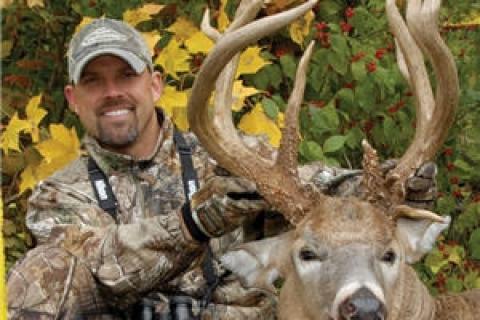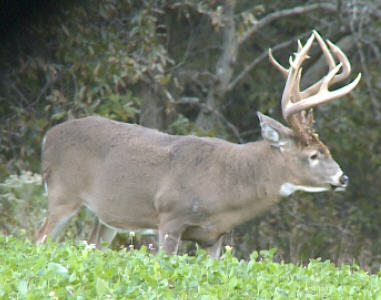
I've taken many big deer over the years, but Gnarles Barkley was the biggest—at 300+ lbs. on the hoof, he was a true monster. This meek, elusive behemoth had been on my mind for three years, ever since the day I saw what looked like an elk horn laying in the snow.
I had just purchased a farm in Iowa—the previous owners had overhunted the property, the fields had all been planted in hay, and most of the old timber had been cleared away, letting cedar thickets pop up and take over where hardwoods had once dominated. Not ideal whitetail habitat. But we could see potential. It would take a lot of work, and a lot of patience.  I set up a few feeders almost immediately, even before thoroughly scouting the property. On one of our first work days on the new farm, Tiffany and I were cleaning out the barn, and I decided to walk over to one of the closer feeders and take a quick look. In the snow ahead, I spotted what looked to be a long, curved elk shed! As I approached, I realized that it was 2 sheds, one facing up, one down, in a line so they looked like one long antler. They were incredibly massive. It was my first contact with a deer that would be a three year obsession.
I set up a few feeders almost immediately, even before thoroughly scouting the property. On one of our first work days on the new farm, Tiffany and I were cleaning out the barn, and I decided to walk over to one of the closer feeders and take a quick look. In the snow ahead, I spotted what looked to be a long, curved elk shed! As I approached, I realized that it was 2 sheds, one facing up, one down, in a line so they looked like one long antler. They were incredibly massive. It was my first contact with a deer that would be a three year obsession.
We began turning over hay that spring, planting clover, turnips, and beans, and we saw lots of does and younger bucks. Tiffany was standing on back of the planter one day, when she caught a glimpse of a big buck near the edge of the field. She described a tall, thick rack, with stickers. We weren't sure if it was the same deer that dropped the sheds near the barn, but made note of the sighting.
By the next year, the food plots had tripled the amount of deer on the property, and I found another shed from the big buck, whom I had named Gnarles Barkley. The right antler had a number of abnormal stickers, and after searching for three weeks, I found the other side. Both were on the same ridge where I had found the first set. My obsession clicked up a few notches, and we began planning to take him down.
I was planting clover one day when I saw him for the first time, standing in the south bean fields, his narrow but massive rack obviously the same as the four sheds I'd found, The game ratcheted up again.
We started getting numerous pictures of Gnarles, and could tell that he, like many older bucks, had developed a mild attitude, commonly letting the younger bucks chase him away. By turning the other antler, he had managed to survive well into old age—I estimated he was 8-1/2 to 11-1/2 years old. And he was huge—one of the biggest whitetails I've ever seen. It was strange to a 300+ lb. giant with such imposing antlers getting pushed around by young upstarts. And as the number of young buck sightings began to increase, I decided I'd better get a stand put in and take him before the young'uns pushed him off the farm completely.
I dozed out a small clover field, on the other side of the timber where I thought he was spending his days, and placed an extremely well-hidden ground blind in the edge of the cedars. This was 200-300 yards north of the bean fields, and I thought I could switch him to the clover once the beans withered. And I was right.  Tiffany and I left the farm in late August for an elk hunt, and when we returned on October 3rd, I was eager to know whether Gnarles' habits had changed. The day we returned, we walked up the road to the clover patch—I had put an s-curve in the trail so we could approach unseen—and when I looked around the corner, there was one deer standing in the field. Gnarles Barkley himself. I cursed myself silently for not coming home a day early, and then we slowly backed out.
Tiffany and I left the farm in late August for an elk hunt, and when we returned on October 3rd, I was eager to know whether Gnarles' habits had changed. The day we returned, we walked up the road to the clover patch—I had put an s-curve in the trail so we could approach unseen—and when I looked around the corner, there was one deer standing in the field. Gnarles Barkley himself. I cursed myself silently for not coming home a day early, and then we slowly backed out.
My regular cameraman George was out for vacation, so Tiffany and I headed to the blind—her with a camera, me with a bow. Soon after we settled in, the big guy came out to our extreme right, in the worst possible place, where she couldn't film and I couldn't shoot. And worst of all, he never took his eyes off the blind. He froze for a number of minutes, staring up as educated deer sometimes do. I think it was because the mesh windows had been opened, and he could see the difference in the way the blind looked. After taking a few tentative bites of clover, never taking his eyes off the blind for more than a couple of seconds, he stepped back into the woods the way he'd come in, never offering a shot with camera or bow.
Normally I wouldn't hunt the same stand too many days in a row, but the blind was so well concealed, and I was so concerned that the young bucks would drive off Gnarles, I hunted it several days in a row unless the wind was wrong.
On October 7th, George rejoined me with the camera, and we snuck into the stand, this time setting up for an appearance by the gigantic buck on the right—and wouldn't you know it, he came out on the right. He was preceded by a smaller buck that stepped into the clover and began to make a scrape, and when the little buck saw Gnarles approaching, he challenged him. This was to my advantage, as it pushed my target into the middle of the plot. He was still too far away, but slowly fed straight towards me, and finally turned broadside at 50 yards.
This was it. I drew my bow—aiming a little low, since at this distance, most bucks will jump the string starting with a quick duck—and released the arrow. The monstrous buck wheeled and ran into the woods, and I worried that I had made a bad shot, but George assured me that he had seen blood pouring out as he turned. The great Gnarles Barkley expired just inside the treeline.
The rack was even bigger than I had thought—the massive non-typical 4x4 antlers had bases as big as my wrists, and grossed 197 inches. In body size, it was the largest whitetail I had ever taken, field dressing at over 250 lbs.
Customizing my planting and learning the habits of this old deer were the keys to my success. I basically built a place for him, where he felt unthreatened, and planted it with a food that he could easily transition to in late fall when the beans died back.
It all paid off—and it remains one of the most incredible hunts of my life.
- 19590 views

